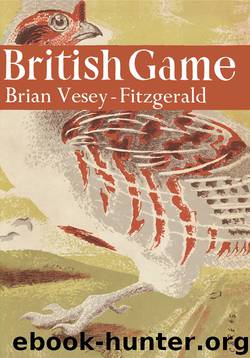British Game by Brian Vesey-Fitzgerald

Author:Brian Vesey-Fitzgerald [Brian Vesey-Fitzgerald ]
Language: eng
Format: epub
ISBN: 9780007406067
Publisher: HarperCollins Publishers
THE EIDER DUCK (Somateria mollissima mollissima (Linnaeus))
A resident. The drake, with his black crown, black flanks and underparts, and black tail boldly contrasted with the white of the rest of the body, is unmistakable. The duck is warm brown mottled and streaked with black. Quite apart from the colouring, both sexes may be recognised at once by their heavy build and the flat shape of the head. In flight the whole forewing of the drake is white. The drake is in full plumage from about the end of November until the end of June. The eclipse plumage is blackish, giving the bird a dingy appearance, rather as if it had been dipped in soot. The bill is yellowish-green at the base and bluish-green at the tip with a greyish-white nail. The legs and feet are yellowish-green.
In England the eider breeds only along the coast of Northumberland, on the Farne and Coquet Islands, and on Holy Island. In Scotland it breeds along the east coast from Berwick to Aberdeen, along the north Sutherland coast, along the west coast in suitable places down to Wigtownshire. In Ireland it breeds only on islands off the Donegal coast. It is common in Orkney and Shetland. In winter it can only be regarded as uncommon south of its breeding range, but it does occur in small numbers at irregular intervals all around our coasts from October to March, and I have seen a drake in full plumage off the Isle of Wight in May.
For breeding purposes it likes low-lying coasts and islands with sandy shores and plenty of rocks. In most of its British breeding range it nests close to the sea, but in the Outer Hebrides and Shetland it nests also on hills and lochs inland. It is a social nester, and where undisturbed or protected these colonies sometimes attain great numbers. The nest, made of grass and seaweed or any other handy vegetation, is lined with down and feathers in a most liberal manner, and is built by the duck. The usual number of eggs is about six, but numbers far in excess of this, probably due to the layings of two females, are not uncommon. Nests are often very close together, and the eider duck is not over particular about laying in her own nest. The colour of the eggs is very variable. Pale olive is probably the most common, but I have seen green, greenish-grey, buff, buffish-yellow, and bright blue eggs. In Northumberland they are laid from mid-May onwards, in Scotland rarely before June, and incubation, which lasts four weeks, is by the duck alone. The young are taken to the water by the duck as soon as they are dry, but they take little notice of their mother after that, attaching themselves to any duck that happens to be about and being tended by her. They form, in fact, nurseries under the charge of one female.
Outside the breeding season the eider is exclusively marine. Generally it stays well out to
Download
This site does not store any files on its server. We only index and link to content provided by other sites. Please contact the content providers to delete copyright contents if any and email us, we'll remove relevant links or contents immediately.
Sapiens: A Brief History of Humankind by Yuval Noah Harari(14248)
The Tidewater Tales by John Barth(12608)
Mastermind: How to Think Like Sherlock Holmes by Maria Konnikova(7224)
Do No Harm Stories of Life, Death and Brain Surgery by Henry Marsh(6887)
The Thirst by Nesbo Jo(6826)
Why We Sleep: Unlocking the Power of Sleep and Dreams by Matthew Walker(6618)
Life 3.0: Being Human in the Age of Artificial Intelligence by Tegmark Max(5474)
Sapiens by Yuval Noah Harari(5293)
The Longevity Diet by Valter Longo(5017)
The Body: A Guide for Occupants by Bill Bryson(4974)
The Rules Do Not Apply by Ariel Levy(4850)
The Immortal Life of Henrietta Lacks by Rebecca Skloot(4525)
Animal Frequency by Melissa Alvarez(4394)
Why We Sleep by Matthew Walker(4359)
The Hacking of the American Mind by Robert H. Lustig(4318)
Yoga Anatomy by Kaminoff Leslie(4303)
All Creatures Great and Small by James Herriot(4231)
Double Down (Diary of a Wimpy Kid Book 11) by Jeff Kinney(4206)
Barron's AP Biology by Goldberg M.S. Deborah T(4096)
